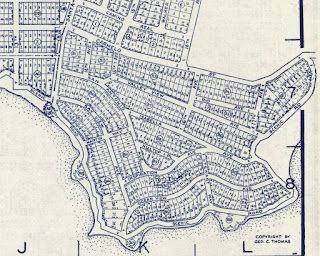Scenic Road is a 1.5-mile street located in and around the city of Carmel-by-the-Sea, California. The corridor was developed as part of a 1902 subdivision which formed the basis for the modern Carmel town plot. The routing of Scenic Road follows Carmel Bay from Ocean Avenue southward Mara Beach by the Carmel River. The street offers numerous coastal views, is free to use and aligned for southbound-only traffic.
Part 1; the history of Scenic Road
Prior to European contact Carmel Valley was home to numerous local tribes. The area was first explored by Europeans during a 1542 Spanish expedition led Juan Rodriguez Cabrillo. The Cabrillo expedition sailed along the coastline north through Big Sur, Carmel Valley and Monterey Peninsula, but made no attempt to land.
In 1602 Sebastián Vizcaíno discovered Carmel Valley at the behest of Spain and named the river running through it Rio Carmel. The name is thought to be an honorific reference to three Carmelite friar which were part of the expedition. The Spanish would not attempt to colonize the area until 1770 when the Catholic Mission San Carlos Borromeo de Carmelo was established.
Following the Mexican-American War the lands around Carmel Bay became part of the American state of California. Numerous settlers would buy up plots of land on Carmel Bay and Carmel Valley from the 1850s through the 1880s. During 1889 Monterey property developer Santiago J. Duckworth filed a subdivision map with Monterey County. The subdivision plot was simply known as "Carmel" and the area would even receive erratic on/off Postal Service.
During 1902, James Franklin Devendorf and Frank Hubbard Powers, would submit another subdivision map with Monterey County which established much of the modern town plot of Carmel. The plot included what is now "Scenic Road" which ran along the waterfront of Carmel Bay. The community would incorporate as the city of "Carmel-by-the-Sea" on October 31, 1916. The name "Carmel-by-the-Sea" was a reference to the early publicity campaign to spur interest in the area.
Scenic Road appears in detail on the 1938 Thomas Brothers Map of Carmel-By-The-Sea.
Part 2; a drive on Scenic Road
Scenic Road begins from the western terminus of Ocean Avenue at the parking lot for Carmel Sunset Beach. Traffic is forced to loop through the parking lot to reach the one-way only southbound Scenic Road.
Scenic Road follows the course of Carmel Bay southward and dips inland to a terminus at the parking lot for Mara Beach. The corridor passes numerous beaches and higher end homes built along the coastline. At Mara Beach traffic transitions to the two-way Carmelo Street heading northbound.















































Comments